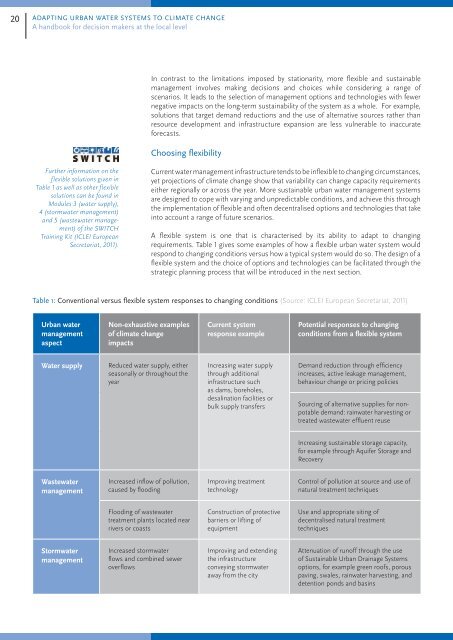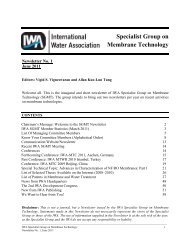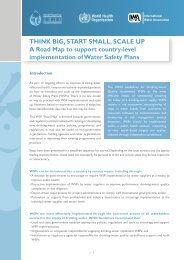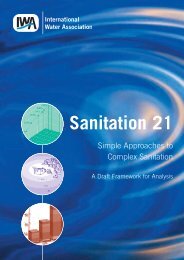AdApting urbAn wAter systems to climAte chAnge - IWA
AdApting urbAn wAter systems to climAte chAnge - IWA
AdApting urbAn wAter systems to climAte chAnge - IWA
Create successful ePaper yourself
Turn your PDF publications into a flip-book with our unique Google optimized e-Paper software.
20 Adapting urban water <strong>systems</strong> <strong>to</strong> climate change<br />
A handbook for decision makers at the local level<br />
Section 2<br />
A strategic planning framework for adaptation<br />
21<br />
Further information on the<br />
flexible solutions given in<br />
Table 1 as well as other flexible<br />
solutions can be found in<br />
Modules 3 (water supply),<br />
4 (s<strong>to</strong>rmwater management)<br />
and 5 (wastewater management)<br />
of the SWITCH<br />
Training Kit (ICLEI European<br />
Secretariat, 2011).<br />
In contrast <strong>to</strong> the limitations imposed by stationarity, more flexible and sustainable<br />
management involves making decisions and choices while considering a range of<br />
scenarios. It leads <strong>to</strong> the selection of management options and technologies with fewer<br />
negative impacts on the long-term sustainability of the system as a whole. For example,<br />
solutions that target demand reductions and the use of alternative sources rather than<br />
resource development and infrastructure expansion are less vulnerable <strong>to</strong> inaccurate<br />
forecasts.<br />
Choosing flexibility<br />
Current water management infrastructure tends <strong>to</strong> be inflexible <strong>to</strong> changing circumstances,<br />
yet projections of climate change show that variability can change capacity requirements<br />
either regionally or across the year. More sustainable urban water management <strong>systems</strong><br />
are designed <strong>to</strong> cope with varying and unpredictable conditions, and achieve this through<br />
the implementation of flexible and often decentralised options and technologies that take<br />
in<strong>to</strong> account a range of future scenarios.<br />
A flexible system is one that is characterised by its ability <strong>to</strong> adapt <strong>to</strong> changing<br />
requirements. Table 1 gives some examples of how a flexible urban water system would<br />
respond <strong>to</strong> changing conditions versus how a typical system would do so. The design of a<br />
flexible system and the choice of options and technologies can be facilitated through the<br />
strategic planning process that will be introduced in the next section.<br />
The flexibility of non-conventional urban water <strong>systems</strong> is often related <strong>to</strong> their<br />
decentralised solutions. Decentralisation decreases sensitivity by spreading risk; indeed,<br />
it is easy <strong>to</strong> understand the heightened risk faced by a city dependent on one or more<br />
large wastewater treatment plants versus a city that operates several smaller-scale natural<br />
treatment <strong>systems</strong> located in different areas.<br />
In addition, decentralised solutions are often quicker <strong>to</strong> install and more cost-effective<br />
<strong>to</strong> build and maintain. These considerations are particularly important in the face of<br />
changing conditions, which can easily render large investments in new treatment facilities<br />
or water supply infrastructure redundant.<br />
COFAS - A water management decision-support <strong>to</strong>ol<br />
The selection of appropriate adaptation measures requires innovative <strong>to</strong>ols that help understand<br />
the flexibility of different options. COFAS (Comparing the Flexibility of Alternative<br />
Solutions), for example, goes beyond the conventional multi-criteria analysis and also visualises<br />
the inherent ability of a potential solution <strong>to</strong> respond flexibly under different scenarios.<br />
Source: Ingenieurgesellschaft Prof. Dr. Sieker mbH, Germany<br />
Table 1: Conventional versus flexible system responses <strong>to</strong> changing conditions (Source: ICLEI European Secretariat, 2011)<br />
Urban water<br />
management<br />
aspect<br />
Non-exhaustive examples<br />
of climate change<br />
impacts<br />
Current system<br />
response example<br />
Potential responses <strong>to</strong> changing<br />
conditions from a flexible system<br />
Water supply<br />
Wastewater<br />
management<br />
S<strong>to</strong>rmwater<br />
management<br />
Reduced water supply, either<br />
seasonally or throughout the<br />
year<br />
Increased inflow of pollution,<br />
caused by flooding<br />
Flooding of wastewater<br />
treatment plants located near<br />
rivers or coasts<br />
Increased s<strong>to</strong>rmwater<br />
flows and combined sewer<br />
overflows<br />
Increasing water supply<br />
through additional<br />
infrastructure such<br />
as dams, boreholes,<br />
desalination facilities or<br />
bulk supply transfers<br />
Improving treatment<br />
technology<br />
Construction of protective<br />
barriers or lifting of<br />
equipment<br />
Improving and extending<br />
the infrastructure<br />
conveying s<strong>to</strong>rmwater<br />
away from the city<br />
Demand reduction through efficiency<br />
increases, active leakage management,<br />
behaviour change or pricing policies<br />
Sourcing of alternative supplies for nonpotable<br />
demand: rainwater harvesting or<br />
treated wastewater effluent reuse<br />
Increasing sustainable s<strong>to</strong>rage capacity,<br />
for example through Aquifer S<strong>to</strong>rage and<br />
Recovery<br />
Control of pollution at source and use of<br />
natural treatment techniques<br />
Use and appropriate siting of<br />
decentralised natural treatment<br />
techniques<br />
Attenuation of runoff through the use<br />
of Sustainable Urban Drainage Systems<br />
options, for example green roofs, porous<br />
paving, swales, rainwater harvesting, and<br />
detention ponds and basins<br />
Figure 2: Applying COFAS <strong>to</strong> compare two solutions for urban drainage in order<br />
<strong>to</strong> select the most flexible one<br />
Fostering integration across urban management sec<strong>to</strong>rs<br />
As shown in Section 1, the impacts of climate change will be felt in a cross-cutting manner<br />
across different elements of the urban water cycle, but also across all urban management<br />
sec<strong>to</strong>rs. Current approaches <strong>to</strong> urban water management are often fragmented, with<br />
the design, construction and operation of the various elements carried out in isolation<br />
from one another, and with little coordination with other urban management sec<strong>to</strong>rs and<br />
institutions.<br />
This fragmented approach often results in unsustainable practices, for instance when<br />
technical choices have unintended impacts in other parts of the urban system. For<br />
example, the structural means of flood protection applied <strong>to</strong> the Elbe River in Germany<br />
negatively affect eco<strong>systems</strong> (Weschung et al., 2005 as cited in Kundzewicz et al., 2007).<br />
It is also inadequate in terms of responding <strong>to</strong> the challenges posed by climate change.<br />
Integrated Urban Water<br />
Management (IUWM) is a<br />
widely recognised integrated<br />
planning approach. Further<br />
information on IUWM can<br />
be found in Module 1 of the<br />
SWITCH Training Kit (ICLEI<br />
European Secretariat, 2011).
















